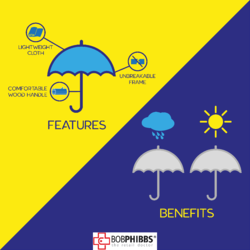Looking to understand and learn how to sell more in your retail store? You need to know that features are not benefits and why the difference matters to customers.
What is a feature?
A feature is a fact. It is something we cannot debate. "This table has four legs" is a fact. We can't debate that it really has three. We can see four.
What is a benefit?
A benefit is what the customer will get from owning a product, but the benefits can be debated because they'll differ for different people. A benefit is something that the salesperson believes the customer will enjoy based on what they've said. I might think the particular feature of a thin, polyester fiber makes it perfect for a camping tent, but someone else might say it makes the tent too hot as it doesn't breathe as well as cotton.
You mustn't just pitch a product's features until you have built rapport and understand what is important to the customer.
Most sales associates fail at this because they only know the features of a product and not how to connect its benefits to individual customers.
Once you realize that the only reason someone buys something is from the compelling benefits - what it will give them - you then understand features support the sale but benefits are what make the sale.
How do you introduce features and benefits?
Go outside and point up to the sky; what will passersby do?
They'll look up in the air.
When they do, and they don’t see anything, they will feel stupid.
The same happens in retail sales when you are stuck selling features and vomit fact after fact. People get bored unless you connect them to what they will get from using it.
It happens when you sell premium coffee and say, “It’s freshly roasted.” Or you're selling a luxury watch and say it has a "ceramic bezel."
Those are just features...
Features are the basic product description facts, but benefits are the reasons a potential customer should buy.
You need to mention the product's benefits to the customer, or you will trip their idiot switch and make them feel stupid.
People won't buy when they feel dumb.
During your retail sales training, you might teach your sales team about the benefit to the customer of a specific feature, such as, "Since coffee loses 25% of its flavor within two weeks of roasting, this is the freshest you can buy."
You could add to the fact of the ceramic bezel of the watch by saying, "So, that makes it very scratch-resistant."
Have you got the picture? This is the fourth part of a sale: features and benefits.
Customers are bored with your product description facts. They are excited by what they can do with the product.
Selling merchandise takes knowing that every product has at least one feature and one benefit: more expensive items, many more. “This travel mug is made of stainless steel so that it won’t add any taste; it cleans easily and won’t break if you drop it.”
Got the idea?
Every day, you use features and benefits in selling people on yourself. “I know the doorman at the club, so I can get us in free.”
“My dad has a new truck I can use, so I can help you move.”
“I know a great restaurant up the street, so it’ll be a great start for our date!”
In Sum
Whenever you point out something about your product, you should imagine the customer saying, “So what!” You need to answer this quickly, or the prospective buyer, in order to avoid looking stupid, will move on or out the door.
Use features and benefits wisely, and you won’t have customers saying So what! to your retail products. They’ll be saying, I'll take it.
With over 100 lessons on engaging a stranger, developing rapport, selling the benefits, handling objections, and more, SalesRX is your secret weapon to explosive growth.


